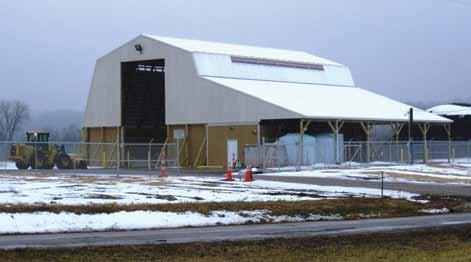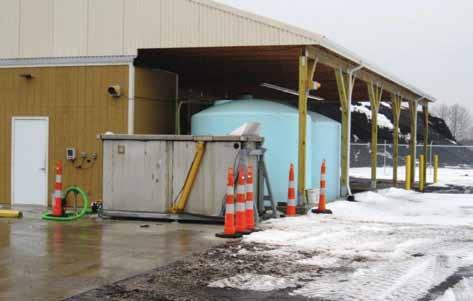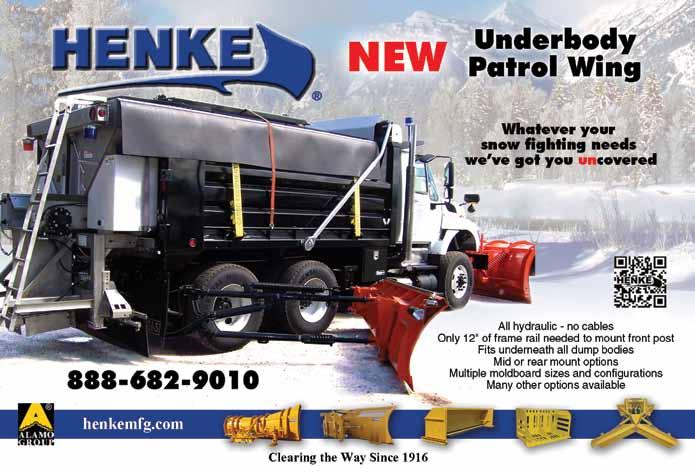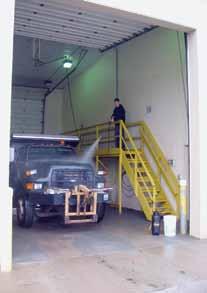
8 minute read
A role model for innovation
Diana Clonch
President, D.W. Clonch Columbus, Ohio President-Elect, APWA Ohio Chapter
Advertisement
hose in quest of a role model for innovation, collaboration, and sustainability within the winter maintenance community can find a shining example in the City of Lancaster, Ohio, located just southeast of Columbus, Ohio. Lancaster, with a population just under 40,000 and roughly 384 lane-miles of roadway, is typical of agencies across the country that struggle to provide adequate levels of service on declining budgets and dwindling resources. From this struggle, the Lancaster Department of Transportation (LDOT) Operation Manager, Greg Hintz, a twenty-twoyear veteran of the department, attributes success to “thinking outside of the box” and a strong support system both internally and externally.
Maintaining adequate service levels in the light of growing economic hardships and heightened environmental awareness necessitated LDOT to actively seek innovative methods. By 2005 the department noticed the increased use of liquids among the snow and ice community and began serious consideration of incorporating the treatment option. Using the State of Ohio Department of Transportation CO-OP purchasing, Hintz was able to purchase equipment to meet his needs from PENGWYN, a local manufacturer. They purchased basic storage and application equipment and began buying salt brine from the Franklin County Engineer (FCE), a local neighbor who had been using and producing liquids for several years using a PENGWYN brine production system. With much success the first year, they bought a second 6,000-gallon storage tank to allow for increased application and over the following two years explored the potential for buying their own brine maker.
Along with accommodating their own need for salt brine supply, LDOT recognized a similar need among many of their neighbors. Discussions with other local entities to support a collaborative effort has led to today’s growing program affording the use of liquids to others who do not have the facilities or funding to support individual brine production systems. In addition to meeting their own needs, approximately half a dozen of the City’s neighbors now have adequate brine supplies. LDOT’s initial investment in 2005 in a 6,000-gallon storage tank and 1,300-gallon distributor has grown from using 25,000 gallons annually for direct application (anti-icing) to over 100,000 annually in anti-icing and pre-wetting as well as production for use by other entities. In 2010 Lancaster used 127,000 gallons of brine and produced another 85,000 for neighboring governments.
In addition to adding liquid use and brine production to their arsenal, LDOT was in dire need of a facilities upgrade—including upgrading their salt storage (a 1974 wooden structure that had seen better days) and equipment maintenance (wash rack). The plan for upgrading in 2008 occurred simultaneously with the availability of stimulus money. Applications for both upgrades were submitted during early 2008 and consequently awarded at 50% money each. The proposed upgrades included provisions of total containment and collection of all runoff for reclaiming and reuse in brine production. The design of the system included working with the manufacturer PENGWYN to redesign pumping system hydraulics and electronics
New 2,400-ton salt storage facility with brine manufacturing and brine storage

Self-cleaning stainless steel mixing hopper, tank storage and confinement
controls were added at the brine station to allow for the use of a proximity reader which allowed them to use key fobs to identify the purchaser and respective quantities. Product is measured accurately to the gallon and is date and time stamped. The data is assembled in a data base and invoices and billing created automatically. Program changes to the PENGWYN Brine Maker were designed, and added by Matt Goedel of PENGWYN, working with Greg to develop this task.
to accommodate reclaiming water, build was approximately $800,000 producing brine, and simplification for both the wash rack and the salt of the material loading into the storage and brine making facility. trucks, thus offering ease of use to the operators. The facility overall is high To accommodate billing for the UnderbodyPatrolWing.qxp 7/9/2012 10:18 AM Page 1 tech. The total cost for design and purchasing of liquid products, Brine is produced on the rich side at about 24% concentration to ensure the delivery of a good product to the neighboring users. The system is set up to produce about 3,500 gallons per hour with an occasional maximum output of 4,500 per hour. With a recent upgrade of a new electric motor from 15 to 25 horsepower production rates should stabilize


Salt piler in operation
around 4,000 gallons hourly. Water supplies are adequate and reclaimed water to date has provided about 25% of water needed for brine production this year (about 3,000 gallons); it is estimated that reclaimed water will supply about 5% of the overall annual quantity produced—this of course will vary with runoff.
Initial design of the new salt barn included expansion on the current footprint to best utilize vertical space. A new barn was constructed and completed in early 2010. The new structure used primarily the same footprint as the old but, through vertical expansion, offered nearly double the capacity. Consideration was given to the materials used in construction, including the use of stainless steel where possible, to provide for an increased life in the new building. While the approach increased initial cost, it offered fewer issues with deterioration and an increased life span of the barn. The old barn was 40 x 72 and the new one is 50 x 80; the new barn holds 2,400 tons versus 1,000 in the old barn. With increased vertical space the issue of stacking the rock salt had to be addressed. Conveyors and stackers were researched and evaluated for performance and price. With a background in mechanics and equipment, Operations Manager Hintz decided to build a hydraulic conveyor/slinger that would take advantage of the newly upgraded facility’s hydraulic components by tying into the same motor and hydraulic system used to power the brine making production system. Again, Greg consulted with the manufacturer representative, Jim Borowski of PENGWYN, to help develop the motor powering the brine unit which had to be upgraded to ensure the delivery of enough oil to power the conveyor. With this assistance from the manufacturer, problems were addressed regarding the power of the motor, programming of the overall system, and adjustments to meet desired outputs. In addition to accommodating the needs of the conveyor, the newly upgraded motor also allowed for multiple simultaneous operations— both brine production and loading are performed without interruption or decreases in production.
The 24-foot conveyor system, with an 18” wide belt, will off-load a 25-ton truck in roughly 12 to 15 minutes providing between 75 tons to 100 tons of rock salt placement per hour. With the capability to stack upwards to 30’ high, the conveyor offers an excellent option to dumping and shoving salt or to paying additional tonnage fees for vendor-supplied piling services. At a total cost of just under $12,000 not only will the conveyor pay for itself within three

Control room
to four years, but it also ensures optimization of rock salt storage in the newly-built facility.
It has been a struggle to continue to move forward, upgrade, and maintain services in lieu of economic hardships and rising prices. The overall increase in the price of salt and fuel has had a very big impact on the purchasing power of the budget. LDOT’s successful approach is attributed to a collaborative effort that has been internal as well as external. For example, the street department and the water department work together to ensure the street department has the water they need for production and the cost for the water is included in the cost per gallon of the product to ensure accurate reimbursement to the water department.

Education on the use of liquids and its benefits is another important part of what makes the program successful. Training includes an ongoing annual program in the fall (half day) discussing treatment types, equipment operations, and dry runs. The department has utilized LTAP for outreach training, taken advantage of manufacturer-provided sessions, and attended regional snow and ice workshops to exchange and grow their knowledge base. Stepping outside of the box to incorporate alternative treatments is encouraged with the workforce, and to find the best solution for any given circumstance is a primary goal. Hintz realizes the importance of extending the education and information sharing to management as well as the workforce. Through the sharing of information and education regarding equipment, treatments, and products, the internal support of management that is so critical to the department’s success is achieved. The managerial support allows for innovation to thrive.

In moving forward Hintz envisions continued equipment upgrades, harnessing new technology, and heightened awareness of developing methods and practices. He would like to explore alternative methods of product delivery to perhaps take advantage of a local rail system for establishing inventory for bulk products (rock salt, gravel) in a more economic manner. Ultimately he hopes to see the brine program grow to provide product to other neighboring communities that currently do not have such means available.
Diana Clonch can be reached at (614) 989-0316 or dwclonch@gmail.com.
LUBRA-SEAL
ALL SEASON Spreader and Conveyor Encapsulant
Apply once to lubricate & seal – Easy, one step application process and your spreaders are all set for winter operations.
Lubricates drag chains – Helps prevent against costly drag chain seizure or breakage all winter long.
Seals components – Creates a protective barrier against corrosive salts and chlorides.
Environmentally responsible and will not wash off.
Trusted by over 40 State Departments of Transportation.
NEUTRO-WASH
Salt & Chloride Neutralizer
Removes white salt residue left behind from pressure washing with detergents – use
NEUTRO‑WASH after every winter storm.
Put a stop to corrosion and expensive repairs – enjoy more efficient equipment that works harder, lasts longer and looks better.
Save thousands of dollars simply by protecting the equipment you already have in your fleet.
PROTECTION • PRESERVATION • PERFORMANCE
www.rhomar.com solutions@rhomar.com










